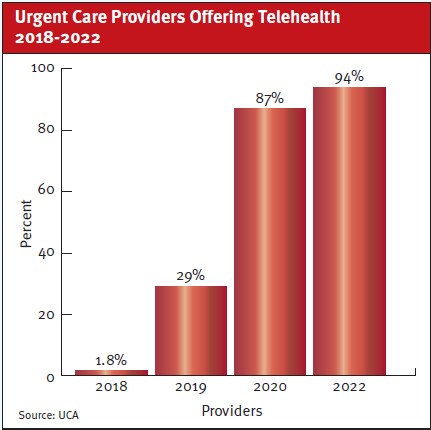Published on
Consumers have come to expect a level of convenience from the healthcare system that parallels the digital innovations they enjoy in retail shopping, banking, and nearly every other aspect of daily life. Patients don’t want to spend time on paperwork, cross-town travel, or cooling their heels in a provider’s waiting room.
Much of the convenience they demand can only be enabled by technology, not the least of which is telehealth. The American Medical Association found that about one-fourth of patients are using virtual care options today, far exceeding the 5% of patients who did so prior to the pandemic. For the future, the association predicts a slow rise of utilization among patients over the next several years.
Urgent care (UC) lends itself well to the use of virtual modalities—whether for patient-to-provider interactions or for interactions between providers to consult on specific cases. Because of its time-sensitive nature, urgent care delivery stands to benefit from channels that allow for immediate response, especially in rural areas that are experiencing access issues.
In terms of payment rates, many commercial insurance plans have opted to reimburse providers for virtual care as a response to consumer demand as well as to maintain access. Policies vary of course, but many UC organizations are finding a telehealth line of business to be profitable.
Additionally, the federal waivers crafted during the pandemic that broadened policies to allow Medicare providers to receive payment for telehealth services delivered to patients in any geographic area are scheduled to end on December 31, 2024. Although telehealth is a back-burner issue, industry leaders continue to advocate for a permanent waiver extension.
These and other factors are driving the steady growth of virtual care. Empowered by technology advancements and favorable reimbursement, telehealth—at least in part—solves for a number of issues, including consumer demand, timeliness of care, and ongoing provider shortages.
The Urgent Care Association (UCA) reported in its recent white paper that UC organizations are almost universally embracing telehealth. Just prior to the pandemic, 29% of organizations offered telehealth, and by 2022, 94% said they offer the service.
What’s noteworthy is that many health specialties demonstrated a rise in telehealth offerings between 2020 and 2021 when the pandemic served as a catalyst for adoption, followed by a backslide in 2022 as in-person care took precedence once again. Urgent care, however, has maintained its growth and competitive advantage, as the UCA reports.
Reference
Urgent Care Association. Urgent Care Industry White Paper, The Essential Nature Of Urgent Care In The Healthcare Ecosystem Post-Covid-19. August 2023. https://bit.ly/3RRxwKq. Accessed October 10, 2023.

